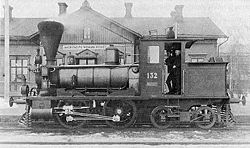
Forney locomotive
Encyclopedia

Tank locomotive
A tank locomotive or tank engine is a steam locomotive that carries its water in one or more on-board water tanks, instead of pulling it behind it in a tender. It will most likely also have some kind of bunker to hold the fuel. There are several different types of tank locomotive dependent upon...
patented by Matthias N. Forney
Matthias N. Forney
Matthias Nace Forney was an American steam locomotive designer and builder. He is most well known for the design of the Forney type locomotive. Locomotives that he designed served the elevated railroads of New York City for many years before that system converted to electric power...
between 1861 and 1864. Forney locomotive
Locomotive
A locomotive is a railway vehicle that provides the motive power for a train. The word originates from the Latin loco – "from a place", ablative of locus, "place" + Medieval Latin motivus, "causing motion", and is a shortened form of the term locomotive engine, first used in the early 19th...
s include the following characteristics:
- An 0-4-4T wheel arrangement, that is four driving wheels followed by a truck with four wheels.
- No flange on the second pair of driving wheels.
- The fuel bunker and water tank placed over the four-wheel truck.
The locomotives were set up to run cab (or bunker) first, effectively as a 4-4-0
4-4-0
Under the Whyte notation for the classification of steam locomotives, 4-4-0 represents the wheel arrangement of four leading wheels on two axles , four powered and coupled driving wheels on two axles, and no trailing wheels...
. The 4-4-0 wheel arrangement, with its three-point suspension, was noted for its good tracking ability, while the flangeless middle wheels allowed the locomotive to round tight curves. Placing the fuel and water over the truck rather than the driving wheels meant the locos had a constant adhesive weight, something other forms of tank locomotive did not.
Large numbers of Forney locos were built for the surface and elevated commuter railroads
Rapid transit
A rapid transit, underground, subway, elevated railway, metro or metropolitan railway system is an electric passenger railway in an urban area with a high capacity and frequency, and grade separation from other traffic. Rapid transit systems are typically located either in underground tunnels or on...
that were built in cities such as New York, Chicago and Boston. These railroads required a small, fast locomotive that tracked well and could deal with tight curves. Their short runs meant the limited fuel and water capacity was not a problem, making the Forney ideal. However, as these railroads began to electrify or were replaced by subways
Rapid transit
A rapid transit, underground, subway, elevated railway, metro or metropolitan railway system is an electric passenger railway in an urban area with a high capacity and frequency, and grade separation from other traffic. Rapid transit systems are typically located either in underground tunnels or on...
at the end of the 19th Century, Forneys began to disappear.
Forneys were also popular on the gauge
Rail gauge
Track gauge or rail gauge is the distance between the inner sides of the heads of the two load bearing rails that make up a single railway line. Sixty percent of the world's railways use a standard gauge of . Wider gauges are called broad gauge; smaller gauges, narrow gauge. Break-of-gauge refers...
railroads of Maine
Maine
Maine is a state in the New England region of the northeastern United States, bordered by the Atlantic Ocean to the east and south, New Hampshire to the west, and the Canadian provinces of Quebec to the northwest and New Brunswick to the northeast. Maine is both the northernmost and easternmost...
. The use of these locomotives differed in that they were run smoke stack leading, like a conventional locomotive, and all driving wheels were flanged. The latter resulted in Maine narrow gauge railroads having comparatively broad radius curves. Further developments included the introduction of locomotives with a leading pony truck, giving a 2-4-4
2-4-4
In Whyte notation, a 2-4-4 is a steam locomotive with two unpowered leading wheels followed by four powered driving wheels and four unpowered trailing wheels.-Equivalent classifications:Other equivalent classifications are:...
wheel arrangement. This was done to improve tracking ability in these locomotives.
The 0-4-4T type was a precursor of other designs which may have drawn on the Forney, such as the Boston & Albany and Central of New Jersey 4-6-4T, which have been only called "tank engines". The notable three-foot gauge 2-6-6T Forney was actually an articulated locomotive, in which the boiler and fuel/water tank were on one frame and the engine was articulated to pivot beneath the boiler, such that the valve connecting rods had to be raised in a frame up over the boiler and wide enough to accommodate the articulation of the engine under the boiler.
Today Forney locomotives can still be seen on Maine Narrow Gauge Railroad Museum
Maine Narrow Gauge Railroad Museum
The Maine Narrow Gauge Railroad Company and Museum is located in Portland, Maine, United States. The organization was founded in 1993 and contains a collection of rolling stock and artifacts from the gauge narrow gauge railroads that ran in the state of Maine in the late 19th century and early...
, at the Forney Transportation Museum
Forney Transportation Museum
The Forney Transportation Museum is a transport museum located in Denver, Colorado.It is named after the founder, J.D. Forney, who started Forney Industries, Inc., in Fort Collins.-Collection:...
and on the Disneyland Railroad
Disneyland Railroad
The Disneyland Railroad , originally the Santa Fe & Disneyland Railroad, is a narrow gauge railroad at Disneyland, Anaheim, California, United States, that was inaugurated on the park's live television preview on July 17, 1955. This live steam railway was constructed for $240,000; each of the...
.

